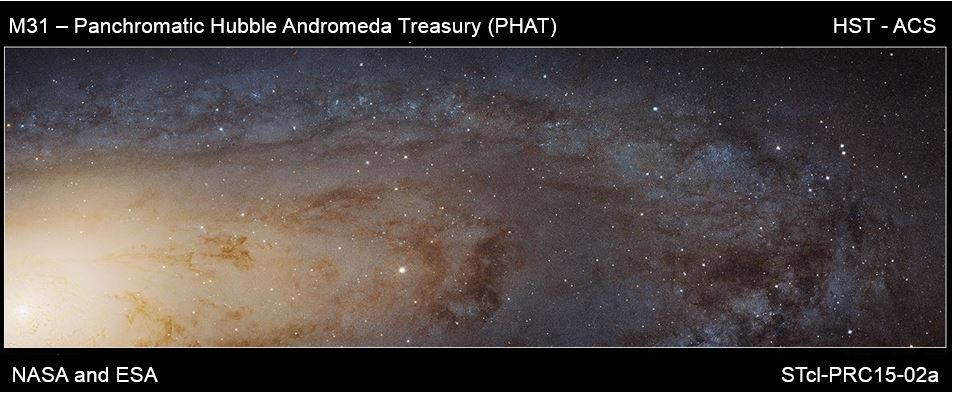NASA’s Hubble Space Telescope has assembled the largest image yet of a portion of the Andromeda galaxy (M31), our galactic next-door neighbor which is more than 2 million light-years away.
The sweeping bird’s eye view of part of the Andromeda galaxy is the sharpest and clearest large composite image ever taken of that part of the Universe.
NASA astronomers say the Hubble Space Telescope has the power to resolve individual stars in a stretch of Andromeda’s pancake-shaped disk which is 61,000 light-years long.
They said creating the image is similar to resolving each individual grain of sand when photographing a stretch of beach. The sweeping view includes an amazing number of stars – more than 100 million of them, some of them in thousands of star clusters seen embedded within the disk.
This ambitions photographic map-making (cartography) effort of the Andromeda galaxy represents a new milestone in precision studies of massive spiral galaxies that dominate the 100 billion galaxies that populate the universe.
“Never before have astronomers been able to see individual stars inside an external spiral galaxy over such a large contiguous area.”
“Most of the stars in the universe live inside such majestic star cities, and this is the first data that reveal populations of stars in context to their home galaxy.”
According to NASA “This sweeping bird’s-eye view of a portion of the Andromeda galaxy (M31) is the sharpest image ever taken of our galactic next-door neighbor.” (Image credit: NASA, ESA, J. Dalcanton, B.F. Williams, and L.C. Johnson (University of Washington), the PHAT team, and R. Gendler.)
The Hubble Space Telescope traces densely-packed stars which extend from the innermost part of the galaxy seen at the left. The view sweeps from Andromeda’s central bulge across lanes of dust and stars to the less densely populated outer disk. The large groups of young blue stars show the locations of star clusters and star-forming regions.
The stars pull together in the blue ring-like feature toward the image’s right side. The dark silhouettes indicate complex dust structures. Throughout the whole of the galaxy there is a smooth distribution of cooler red stars that trace the galaxy’s evolution over billions of years.
The NASA astronomers explained:
“Because the galaxy is only 2.5 million light-years from Earth, it is a much bigger target in the sky than the myriad galaxies Hubble routinely photographs that are billions of light-years away.”
“This means that the Hubble survey is assembled together into a mosaic image using 7,398 exposures taken over 411 individual pointings.”
The image is a product of the PHAT (Panchromatic Hubble Andromeda Treasury) program. The galaxy was viewed using near-ultraviolet, visible, and near-infrared wavelengths, using the Wide Field Camera 3 and the Advanced Camera for Surveys aboard Hubble.
This page’s cropped view shows a stretch of the Andromeda galaxy that is 48,000 light-years long in its natural visible-light color. It was photographed with Hubble’s Advanced Camera for Surveys in red and blue filters.
The panorama was presented at the 225th Meeting of the Astronomical Society in Seattle, Washington.

